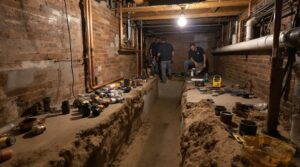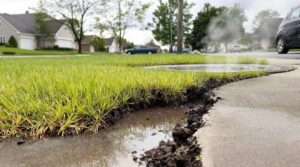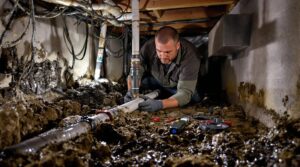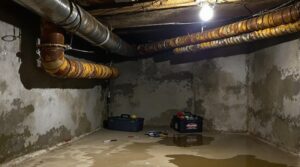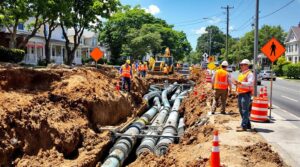Basement floor drains function as essential components in foundation waterproofing systems, positioned at the lowest point of the basement floor. These drains utilize gravitational force to channel water toward collection points, such as sump pumps or municipal sewer systems. The configuration typically incorporates a P-trap mechanism to prevent sewer gas infiltration while managing moisture levels. Understanding the proper maintenance and operation of these critical drainage systems helps protect structural integrity and prevent water damage.
Key Takeaways
- Basement floor drains provide essential water management by collecting and channeling moisture away from your home's foundation to prevent water damage.
- The drain's strategic placement at the lowest point of the basement floor uses gravity to efficiently direct water toward sump pumps or sewers.
- Floor drains protect your basement from flooding during plumbing failures, appliance leaks, or groundwater seepage through foundation walls.
- The P-trap design prevents sewer gases from entering your home while maintaining proper drainage function.
- Building codes often require basement floor drains as a safety measure to prevent structural damage and maintain healthy indoor air quality.
Understanding Your Basement Floor Drain System
When examining residential drainage infrastructure, basement floor drains serve as critical components in maintaining structural integrity and occupant safety. These systems are strategically positioned at the lowest point of the basement floor, utilizing gravitational force to channel excess moisture toward designated collection points, such as sump pump reservoirs or municipal sewer networks.
A properly engineered basement floor drain incorporates essential safety features, including a P-trap mechanism designed to prevent sewer gases from infiltrating the living space. This configuration adheres to local building codes, which mandate specific installation parameters and maintenance protocols.
The system's effectiveness relies on maintaining clear drainage pathways, as clogged drains can compromise its ability to prevent water damage. Regular inspection and maintenance of these drainage systems are imperative, as accumulation of debris, including sediment and organic matter, can impede proper function.
Understanding these fundamental components enables property owners to implement appropriate preventive measures and guarantee peak system performance.
Common Types and Configurations
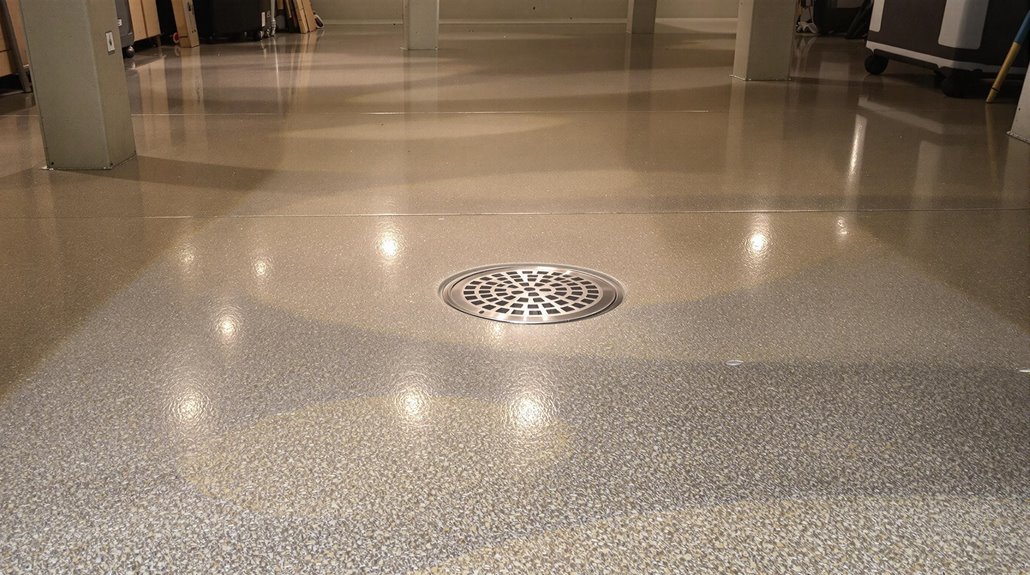
Basement drainage systems encompass several distinct configurations, each engineered to address specific water management requirements in subterranean environments.
The most prevalent plumbing fixture installations include standard floor drains, which can be found in circular, square, or rectangular designs, strategically positioned near water heaters and laundry facilities to manage excess water accumulation.
Common types of basement floor drains incorporate various specialized features:
- Traditional floor drains with grated covers for collecting surface water
- French drain systems utilizing perforated pipes for natural groundwater diversion
- Channel or trench drains designed for extended surface area coverage
- Interior drain systems equipped with sump pits and pumps
Many modern drain systems also integrate backflow prevention mechanisms, particularly in regions susceptible to flooding.
These configurations work in concert to guarantee effective water management, protecting the structural integrity of basement environments while maintaining ideal moisture control.
Signs of a Properly Working Drain
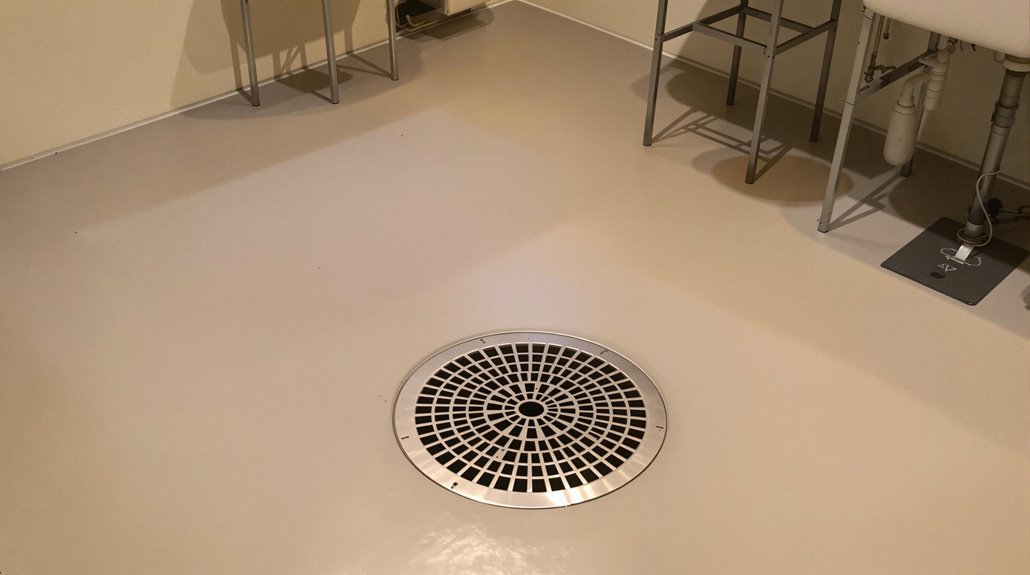
Following the installation of appropriate drainage configurations, homeowners can identify excellent functionality through several key indicators. A properly functioning basement floor drain exhibits specific characteristics that demonstrate its operational efficiency.
The presence of standing water within the drain trap serves as a critical barrier against sewer gases, while maintaining consistent water flow through the system prevents the formation of clogs and unwanted odors.
Observable indicators of superior drain performance include audible drainage sounds during water movement and a clear, unobstructed drain grate. Regular maintenance guarantees the drain remains free from debris accumulation, allowing for efficient water channeling.
The drain's ability to effectively process incoming moisture prevents pooling or water accumulation in the basement area, particularly during periods of heavy precipitation or internal plumbing issues. These performance markers collectively indicate that the drainage system is operating at peak capability and fulfilling its intended purpose.
Maintenance and Prevention Tips
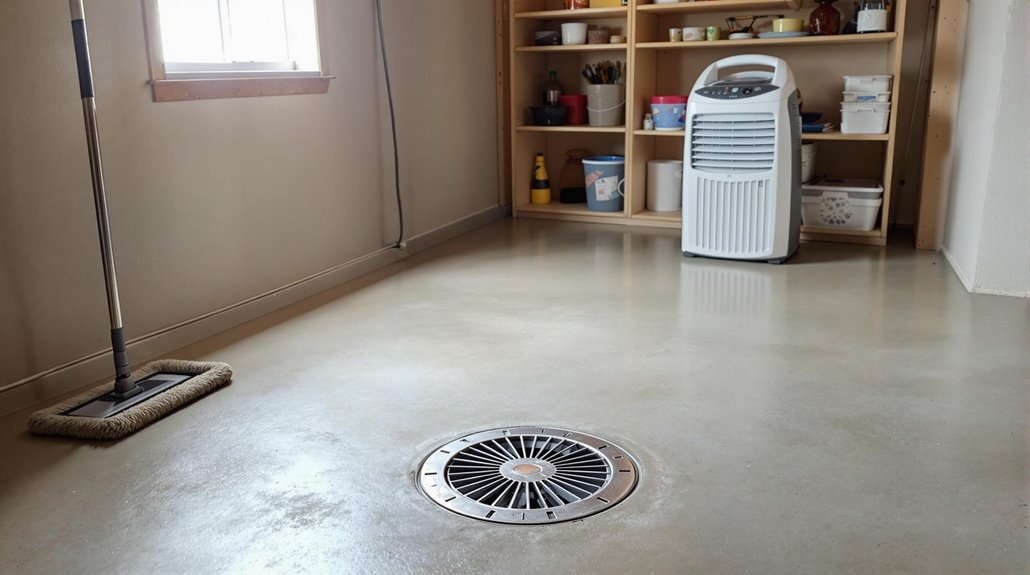
To maintain ideal functionality of basement floor drains, homeowners must implement a thorough maintenance protocol that encompasses regular inspection and preventive measures. Proper maintenance prevents clogged basement floor drains and guarantees optimal performance of the drainage system.
Essential maintenance procedures include:
- Regular inspection of drain covers and strainers for debris accumulation
- Verification of water trap seals to prevent sewer gas infiltration
- Installation and maintenance of backflow preventers in susceptible areas
- Professional system evaluations at scheduled intervals
Proactive maintenance helps identify potential issues before they escalate into significant problems.
The implementation of backflow preventers is particularly vital in areas prone to sewer backup, providing essential protection against basement flooding. Homeowners should maintain adequate water levels in drain traps, especially during seasonal changes when evaporation rates vary.
Regular professional inspections complement these maintenance efforts by evaluating the entire drainage system's integrity and functionality.
Troubleshooting Drain Problems
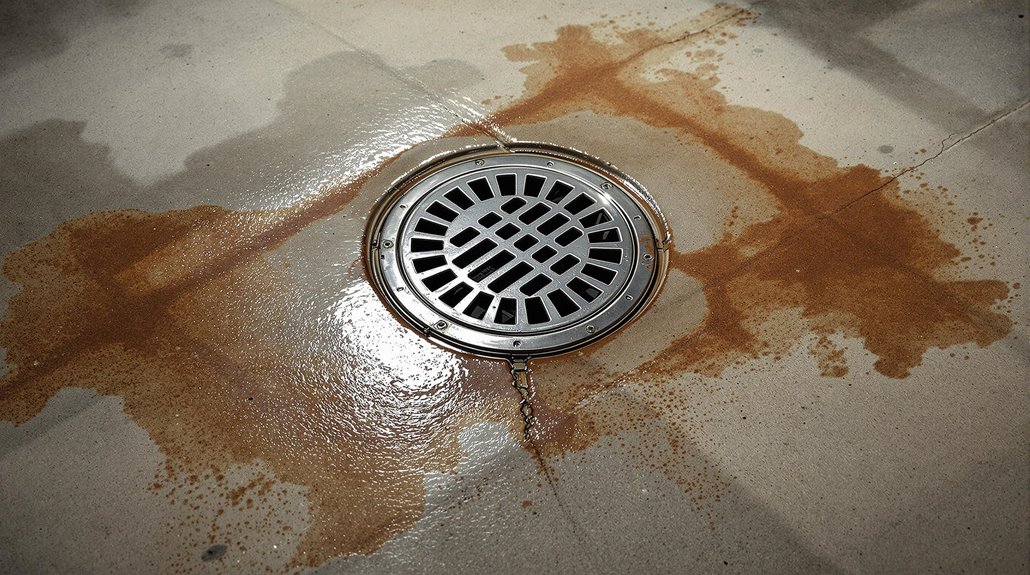
While regular maintenance helps prevent common drainage issues, homeowners may still encounter operational problems that require systematic troubleshooting.
When investigating basement drain problems, the initial assessment should focus on visible signs of dysfunction, including standing water, unusual odors, or slow drainage patterns.
A primary indicator of drain malfunction is water accumulation around the drain opening. This can signify either a clog within the drainage system or potential issues with the main sewer line.
Persistent odors emanating from the drain often indicate a compromised P-trap seal, requiring water addition to restore proper functionality.
In cases where water backs up through the drain during heavy rainfall, installation of a backflow prevention device may be necessary.
For basement areas equipped with a sump pump system, proper integration with the floor drain is essential.
Regular inspection of both systems guarantees ideal water management and prevents flooding scenarios that could compromise basement integrity.
The Benefits Of Consulting A Public Adjuster
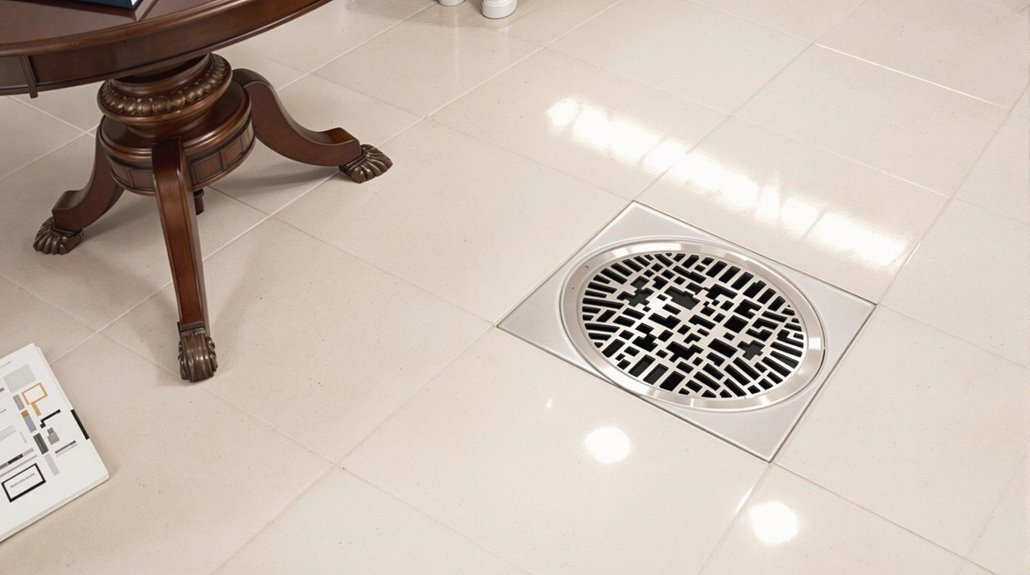
Professional public adjusters provide specialized expertise in basement water damage claims, offering objective damage assessments that often result in settlements up to 800% higher than self-managed claims.
Their extensive understanding of insurance policies and claim procedures guarantees thorough documentation of water-related structural damage, deterioration patterns, and remediation requirements.
Early involvement of a licensed public adjuster ensures proper documentation and maximizes the chances of receiving fair compensation for basement flooding incidents.
Expertise In Insurance Claims
In the aftermath of basement flooding incidents, consulting a licensed public adjuster can greatly enhance the outcome of insurance claims through thorough damage assessment and expert policy interpretation.
These professionals leverage their extensive knowledge to maximize claim settlements, often securing 20-50% higher compensation compared to self-managed claims.
Public adjusters provide critical expertise in documenting water damage through:
- Extensive structural assessment protocols
- Detailed inventory of affected personal property
- Advanced damage detection methodologies
- Strategic policy clause interpretation
Their specialized knowledge enables identification of concealed damages that might otherwise go unnoticed, ensuring proper documentation of all legitimate claims.
This systematic approach to claims management not only streamlines the process but also considerably increases the likelihood of obtaining fair compensation for basement flooding-related losses.
Operating on contingency fee basis, public adjusters typically charge 5-20% of the final settlement amount, making their services accessible to homeowners facing water damage emergencies.
Objective Damage Assessment
Objective damage assessment through a qualified public adjuster establishes a complete baseline for insurance compensation following basement flooding incidents. Public adjusters systematically evaluate water damage to plumbing fixtures, including the basement floor drain, utilizing industry-standard protocols to document losses thoroughly. Fewer than 5% of property owners realize they have the right to hire a public adjuster for claims assessment and representation.
| Assessment Component | Documentation Method |
|---|---|
| Physical Damage | Digital Photographic Evidence |
| Structural Impact | Engineering Analysis Reports |
| Water Damage Extent | Moisture Level Measurements |
The adjuster's unbiased evaluation guarantees accurate quantification of both visible and concealed damage, often identifying issues that might be overlooked during standard insurance inspections. This methodical approach to damage assessment typically results in more favorable claim outcomes, as all aspects of the loss are professionally documented and substantiated with technical evidence supporting the policyholder's position.
Streamlined Claim Process
Engaging a licensed public adjuster greatly expedites the insurance claim process for basement flooding incidents through thorough claim management services. These professionals streamline communications while ensuring extensive documentation of water damage and associated losses.
Key advantages of professional claim management include:
- Expert navigation of complex insurance policies and interpretation of coverage terms
- Accurate damage assessment protocols that often result in higher settlements
- Compliance with local regulations and building codes during remediation
- Efficient processing through established relationships with insurance carriers
Public adjusters operate on contingency fees, typically securing more favorable outcomes through their systematic approach to claims documentation.
Their expertise in water damage assessment, coupled with thorough knowledge of insurance industry practices, facilitates faster claim resolution while maximizing coverage benefits for property owners.
Independent claims adjusters can provide unbiased advocacy during complex negotiations, ensuring fair settlements for property damage claims.
Higher Claim Payouts & Settlements
While homeowners may attempt to navigate insurance claims independently, statistical evidence demonstrates that professional public adjusters consistently secure higher settlement amounts for basement water damage claims.
Research indicates that policyholders utilizing public adjusters receive settlements approximately 30% higher than those who handle claims directly with insurers. This significant difference stems from adjusters' extensive understanding of construction costs, building codes, and damage assessment protocols.
When dealing with basement drain-related water damage, these professionals leverage their expertise to identify all compensable losses, including hidden structural impacts and potential future complications. Their technical knowledge enables them to prepare thoroughly documented claims with supporting evidence, leading to more favorable negotiations with insurance carriers.
This specialized approach guarantees that complex water damage claims receive appropriate valuation and compensation.
The skilled negotiators working as public adjusters can alleviate stress while managing the entire claims process from start to finish.
About The Public Claims Adjusters Network (PCAN)

The Public Claims Adjusters Network (PCAN) operates as a nationwide consortium of state-licensed public adjusters who specialize in processing residential and commercial property damage insurance claims.
The organization maintains strict standards for membership, requiring adjusters to undergo rigorous vetting and demonstrate expertise across multiple claim types, including basement floor damage, sewer backups, and plumbing fixture failures.
PCAN members must meet these essential criteria:
- Hold valid state licensure with annual verification
- Pass intensive application and interview processes
- Demonstrate expertise in 30+ claim categories
- Maintain spotless ethical and professional records
Operating in over 40 states, PCAN serves as a critical intermediary between policyholders and qualified adjusters.
The network's commitment to excellence guarantees that property owners receive expert representation when dealing with insurance claims, particularly in complex scenarios involving structural damage, water intrusion, and related basement infrastructure issues.
Frequently Asked Questions
Is It Normal for a Basement Floor Drain to Have Water in It?
Standing water in basement floor drains is standard for maintaining functional drain traps, preventing sewer gas infiltration and facilitating proper drainage solutions. Regular water accumulation guarantees effective plumbing system operation.
Where Does My Basement Floor Drain Go?
Basement floor drains typically connect to municipal sanitary sewer systems or dedicated drainage systems. Water flow patterns direct basement moisture through underground plumbing to either sump pits or main sewer lines.
Is It Okay to Cover a Basement Floor Drain?
Like a safety gate, covering basement drains is acceptable using perforated grates or removable covers that maintain proper drainage function while preventing debris infiltration, adhering to local plumbing regulations and moisture control standards.
Why Would a Basement Floor Drain Back Up?
Basement floor drain backups commonly result from clogged debris, compromised plumbing systems, insufficient drainage slope, sewer line blockages, or municipal system overload during heavy precipitation events, requiring professional maintenance intervention.
